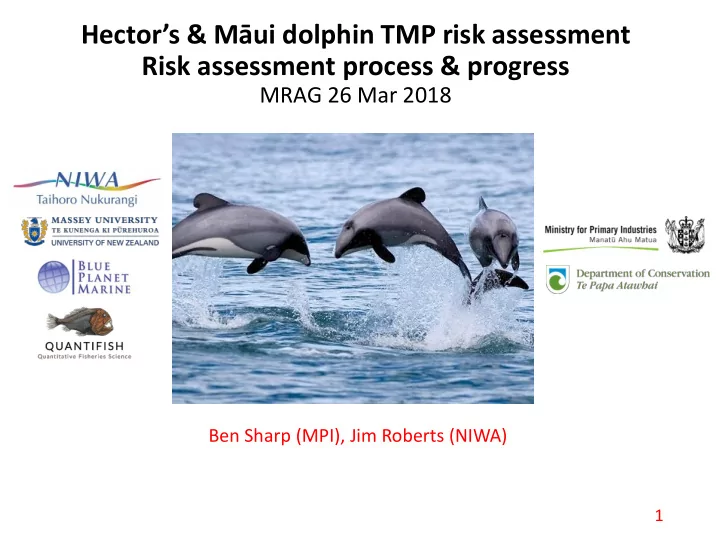

Hector’s & Māui dolphin TMP risk assessment Risk assessment process & progress MRAG 26 Mar 2018 Ben Sharp (MPI), Jim Roberts (NIWA) 1
Evolution of the Hector’s M ā ui TMP 2007 TMP M ā ui & Hectors • PBR for 4 genetic sub-populations • Quantitative assessment of set-net mortalities (Davies et al. 2008) • Qualitative assessment of other threats 2012 TMP M ā ui only • PBR for M ā ui • Expert threat characterization – spatial & magnitude (Currey et al. 2012) • Basic assessment of spatial overlap of threats with M ā ui 2018 TMP M ā ui & Hector’s • Spatially-explicit risk assessment (SEFRA) with seasonality • All key threats to all 4 populations assessed simultaneously • Related to PST (different to a PBR) 2
TMP risk assessment Contract PRO2017-12 (NIWA): Jim Roberts (team leader); + Kim Goetz (spatial distribution modelling); + Charles Edwards and Ian Doonan (population modelling); + Darcy Webber (fisheries threat modelling; SEFRA method; Risk Atlas); + Wendi Roe (Toxoplasmosis) + Simon Childerhouse (other non-fishery threats) - Simultaneously assess risks arising from multiple threats, within the constraints of what can be known from demographic population models - Threats assessments are spatially explicit, with respect to the spatial (and seasonal) distribution of the dolphins and (where possible) the spatial distribution of the threats we don’t just estimate how many deaths are occurring, we can estimate where and when those deaths are occurring spatial management strategy evaluation 3
TMP risk assessment methodology (1) Application of a modified SEFRA methodology (AEBAR 2017 Chapter 3); implementation via the Risk Atlas tool (Webber: MPI contracts PRO2016-06 & SEA2016-30, in progress), building on initial outputs of the Marine Mammal Risk Assessment (Dragonfly DataScience: MPI contract PRO2012-02) and method development by MPI (2017) and Webber & Sharp (today’s presentation) Risk = Fatalities / ‘Sustainable limit’ (biology) 𝑆 𝑡 = 𝐸 𝑡 𝑄𝑇𝑈 𝑡 Calculation of Population Suitability Threshold ( PST ) – annual mortality that will allow population recovery or stabilization to [X] % of K with [Y] % certainty, including inter-annual stochasticity 𝑄𝑇𝑈 = 1 2 . 𝜒. 𝑠 𝑛𝑏𝑦 . 𝑂 4
TMP risk assessment methodology (2) 𝑄𝑇𝑈 = 1 2 . 𝜒. 𝑠 𝑛𝑏𝑦 . 𝑂 This will be related to threat-specific deaths (D T ), given overlap between the spatial distribution of Hector’s & Mā ui dolphins and spatial threat intensity For fisheries threats, death rate per encounter (‘vulnerability’) is estimated empirically based on observed capture rates: Fatalities = Effort * Overlap * Vulnerability * population size 𝐸 𝑡𝑗 = 𝐹 ∗ 𝑃 𝑡𝑗 ∗ 𝑤 𝑡 𝑤 ∗ ℕ 𝑡𝑗 𝑆 𝑡 = 𝐸 𝑡 𝑄𝑇𝑈 𝑡 5
TMP risk assessment methodology (3) (3) Modifications to SEFRA method • Population specific demographics: where data exist, we can estimate and apply adult survival S per sub-population • Adult survival constrains the estimate of total deaths: .... And then we partition these deaths between possible sources of mortality S = 1 – (M + U + T1 + T2 + T3….) “There is only so much death to go around” • Lethal non-fishery threats can be apportioned based on necropsy results (requires assumptions about observability of bodies) • Jim’s presentation later today 6
TMP risk assessment methodology (4) (4) What about non-lethal threats? • E.g. effects on habitat, or behavioural responses • For spatially resolved threats (oil and gas, mining, pollution), in the SEFRA framework we can still estimate every term in this equation except for ‘vulnerability’ 𝐸 𝑡𝑗 = 𝐹 ∗ 𝑃 𝑡𝑗 ∗ 𝑤 𝑡 𝑤 ∗ ℕ 𝑡𝑗 The ‘D’ now refers to ‘displacement’ rather than deaths, and can be disaggregated and mapped in space and time to inform management (this is where we were for Maui fishery threats in 2012) 7
Other novel approaches: use of public and/or fishery observer sightings to inform spatial distribution of M ā ui & Hector’s dolphins How many people have seen dolphins in each location? How many people might were in that location that could have seen them? (William’s presentation today will generate inputs for this approach) 8
Spatial dolphin distributions: Use of fisheries observer sightings data 9
TMP risk assessment science review process: 2018 Demographic assessment: 7 March 2018 • Review life history info for Rmax • Current adult survival • Small population-size effects Threat characterization: 17 April 2018 • Identification of threats • Spatial distribution of threat intensity • Preliminary threat estimation (fisheries, others) Hector’s & Mā ui seasonal spatial distribution: 30 May 2018 • Predictive modelling of dolphin distribution by season from aerial surveys (e.g. MacKenzie & Clement 2016) • Integration of new data from CPOD studies, boat-based surveys, fisheries observer sightings, public sightings, etc Non-fishery and non-lethal threats intensity / effects: June 2018? 10
TMP risk assessment workshop Hector’s and Maui dolphins multi -threat risk assessment workshop: July 2018 • Review SEFRA model inputs • Implement multi-threat SEFRA model • Estimate/illustrate effects of alternative management scenarios on risk using Risk Atlas (Darcy’s presentation today) • Workshop reporting Three confirmed international expert reviewers / evaluators • Mike Lonergan, Randall Reeves, Barbara Taylor Risk assessment reporting: late 2018 TMP update consultation/ decision: early 2019? 11
Timeline of review opportunities Aug 2017 – Technical WG, introduction & extending SEFRA for TMP Sep 2017 – risk assessment begins Nov 2017 – Toxoplasmosis workshop at Massey Nov 2017 – AEWG, risk assessment process & progress update 7 Mar 2018 – AEWG Demographic assessment 26 Mar 2018 – MRAG, progress update 17 Apr 2018 – AEWG Threat characterisation 30 May 2018 – AEWG M ā ui /Hector’s spatial distribution Jul 2018 – Maui- Hector’s dolphin multi -threat risk assessment workshop Sep - Nov 2018 – TMP risk assessment draft & final reporting 12
Recommend
More recommend